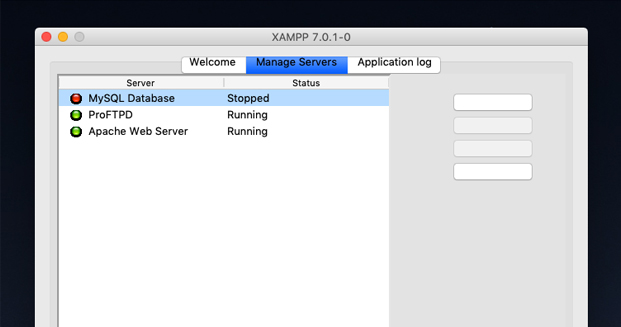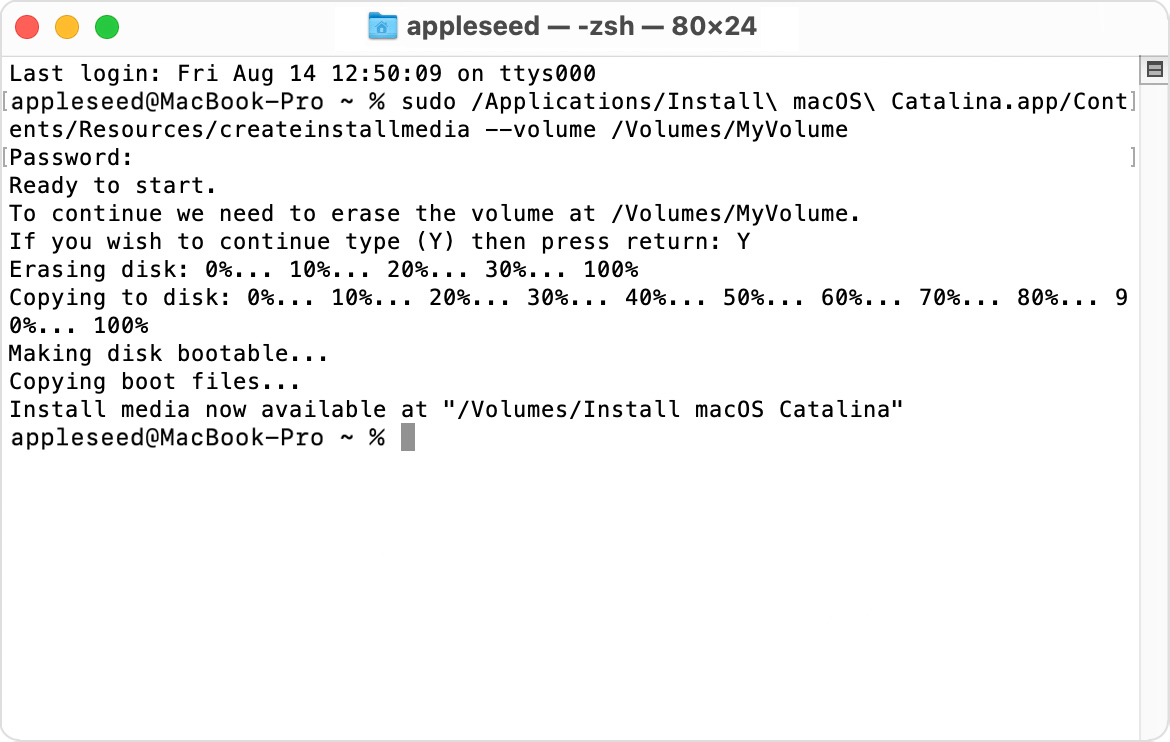Mysql Start Macos
When I try to start MySql in XAMPP control panel (v3.2.1) I have the following message and MySql does not start. 23:02:03 mysql Problem detected! 23:02:03 mysql Port 3306 in use by 'C: Program Files MySQL MySQL Server 5.1 bin mysqld' -defaults-file='C: Program Files MySQL MySQL Server 5.1 my.ini' MySQL'! 23:02:03 mysql MySQL WILL NOT. How to install, start and test XAMPP on Mac OSX. XAMPP is a free distribution package that makes it easy to install Apache Web Server, PHP, PEAR, and MySQL. Before installing XAMPP, you should turn off any other web servers and instances of MySQL you have running on your Mac.
Summary: in this tutorial, you will learn step by step how to install MySQL on the Windows platform using the MySQL Installer. After the tutorial, you will have a MySQL server and its tools up and running on your system for learning and practicing.
Note that if you use other operating system platforms such as Linux and macOS, you use the following tutorial: Mojave os upgrade.
#First: Install NodeJS 12+, NPM, and Yarn #. Fork the Beekeeper Studio Repo (click fork button at top right of this screen) # 2. Check out your fork: git clone git@github.com: /beekeeper-studio.git beekeeper-studio cd beekeeper-studio/ yarn install # installs dependencies # Now you can start the app: yarn run electron:serve # # the app will now start. Import data from an external MySQL DB instance into an Amazon RDS DB instance by first dumping it using the mysqldump command line utility. You then import it using the LOAD DATA LOCAL INFILE command and use replication to bring the instances into sync.
Download MySQL Installer
If you want to install MySQL on the Windows environment, using MySQL installer is the easiest way. MySQL installer provides you with an easy-to-use wizard that helps you to install MySQL with the following components:
- MySQL Server
- All Available Connectors
- MySQL Workbench with Sample Data Models
- MySQL Notifier
- Tools for Excel and Microsoft Visual Studio
- MySQL Sample Databases
- MySQL Documentation
To download MySQL installer, go to the following link http://dev.mysql.com/downloads/installer/. There are two installer files:
- If you are connecting to the internet while installing MySQL, you can choose the online installation version
mysql-installer-web-community-<version>.exe. - In case you want to install MySQL offline, you can download the
mysql-installer-community-<version>.exefile.
Install MySQL via MySQL Installer
To install MySQL using the MySQL installer, double-click on the MySQL installer file and follow the steps below:
Install MySQL Step 1: Windows configures MySQL Installer
Install MySQL Step 2 – Welcome Screen: A welcome screen provides several options. Choose the first option: Install MySQL Products

Install MySQL Step 3 – Download the latest MySQL products: MySQL installer checks and downloads the latest MySQL products including MySQL server, MySQL Workbench, etc.
Install MySQL Step 4: Click the Next button to continue
Install MySQL Step 5 – Choosing a Setup Type: there are several setup types available. Choose the Full option to install all MySQL products and features.
Install MySQL Step 6 – Checking Requirements
Install MySQL Step 7 – Installation Progress: MySQL Installer downloads all selected products. It will take a while, depending on which products you selected and the speed of your internet connection.
Install MySQL Step 7 – Installation Progress: downloading Products in progress.
Install MySQL Step 7 – Installation Progress: Complete Downloading. Click the Next button to continue…
Install MySQL Step 8 – Configuration Overview. Click the Next button to configure MySQL Database Server
Install MySQL Step 8.1 – MySQL Server Configuration: choose Config Type and MySQL port (3006 by default) and click Next button to continue.
Install MySQL Step 8.1 – MySQL Server Configuration: choose a password for the root account. Please note the password download and keep it securely if you are installing MySQL database server on a production server. If you want to add a more MySQL user, you can do it in this step.
Install MySQL Step 8.1 – MySQL Server Configuration: choose Windows service details including Windows Service Name and account type, then click Next button to continue.
Install MySQL Step 8.1 – MySQL Server Configuration – In Progress: MySQL Installer is configuring MySQL database server. Wait until it is done and click the Next button to continue.
Install MySQL Step 8.1 – MySQL Server Configuration – Done. Click the Next button to continue.
Install MySQL Step 8.2 – Configuration Overview: MySQL Installer installs sample databases and sample models.
Install MySQL Step 9 – Installation Completes: the installation completes. Click the Finish button to close the installation wizard and launch the MySQL Workbench.
In this tutorial, you have learned how to install MySQL on your Windows system using the MySQL installer.
XAMPP is a free distribution package that makes it easy to install Apache Web Server, PHP, PEAR, and MySQL. Before installing XAMPP, you should turn off any other web servers and instances of MySQL you have running on your Mac.
XAMPP is a free distribution package that makes it easy to install Apache Web Server, PHP, PEAR, and MySQL. Before installing XAMPP, you should turn off any other web servers and instances of MySQL you have running on your Mac.

Installing XAMPP on a Mac
- Download XAMPP for Mac OSX - Be sure to select the proper version of PHP. For Webucator classes, any version after 5 will be fine.
- Open the downloaded file (the DMG-Image).
- Drag and drop the XAMPP folder into your Applications folder.
Starting XAMPP on OSX
To start XAMPP simply open XAMPP Control (by going to /Applications/XAMPP/manager-osx.app in Finder) and start Apache and MySQL on the Manage Servers tab.
If MySQL Does Not Start
If your MySQL server isn't starting, you may need to set the permissions for it using Terminal with this command:
Testing your OSX XAMPP Installation
In your web browser, go to http://localhost. You should see the start page of XAMPP:
Class File Permissions
- Cmd+click on the ApplicationsXAMPPxamppfileshtdocs folder and select 'Get Info'.
- If the lock symbol at the bottom indicates that this information is locked, click the lock icon to unlock, and enter your user credentials.
- Once the settings are unlocked, choose 'everyone' under 'Sharing & Permissions' and change the option to 'Read & Write'.
Class Files
- Download the class files.
- After downloading the class files, navigate to ApplicationsXAMPPxamppfileshtdocs and create a new folder named Webucator and extract your class files in that folder.
Mysql Start Mac
Setting the MySQL Password on Macs
- The PHP files use 'pwdpwd' for the MySQL root password, while the default password is NO password.
- Change the password to pwdpwd by opening Terminal (Applications > Utilities > Terminal) and enter:
You will be asked to enter your Mac password; enter it and press enter. Then you will be asked if you want to set a password for your XAMPP pages, then for MySQL, and then for MySQL/phpMyAdmin user..to all of these just type 'n' for no and press enter.
Then it will say:
- Enter 'y' for 'yes, let me set a password for the root user' and press Enter
- Enter the password pwdpwd. You will be asked to enter it again for confirmation.
- Quit Terminal (Cmd+Q) and restart Apache and MySQL using the XAMPP Control Panel.
Testing phpMyAdmin
- Go to http://localhost
- Click on phpMyAdmin under Tools
- Enter 'root' for username
- Enter 'pwdpwd' for password
You should be able to get in.
Installing Northwind Database using XAMPP
NOTE: you should download the class files below before following these instructions, as it contains the Northwinds Database file(s).
- To install the Northwind database used in class, click on the 'phpMyAdmin' link on the left navigation bar of the XAMPP home page. That should take you to http://localhost/phpmyadmin.
- If it asks you to login, the username is root and the password is blank (unless you have already changed it to something else, like pwdpwd).
- On that page, click on the Import link under the Localhost heading.
- Browse to the Northwind-MySQL.sql file in your class files.
- Click the Go button on the bottom right of the page.
- You should get a Success message and Northwind should be added to the Database dropdown menu on the upper left of the page.
Recommended Editor
- Visual Studio Code ( Download, Install, and Set up)
- While you may use a different editor or IDE, Visual Studio Code is an excellent IDE to learn to code on. It provides a nice balance of power and simplicity and it is available on Windows and Mac.
Designate your testing server in Dreamweaver
NOTE: The following only applies if you are using Dreamweaver. If you are not, please ignore this section.
- Go to Site > New Site.
- In the Site Setup dialog, fill in the Site Name (e.g., PHP) and browse to the Local Site Folder (e.g., ApplicationsXAMPPxamppfileshtdocs).
- Choose the Servers tab.
- At the bottom of the box on the right, click +.
- On the Basic tab, provide a Server Name, set Connect using to Local/Network, ensure the Server Folder matches the local site folder you specified in step 2, and set the Web URL to http://localhost/Webucator/ClassFiles/.
- Click the Advanced button.
- In the Server Model field, select PHP MySQL.
- Click Save. The server should appear in the table on the Servers tab.
- Make sure that both the Remote and Testing checkboxes are checked.
- Click Save.
Testing PHP Files
All your class files should be located in ApplicationsXAMPPxamppfileshtdocsWebucatorClassFiles
Mysql Start Macos Catalina
2 Methods for Testing Files in Browser
To test any of the class files in your browser, say ApplicationsXAMPPxamppfileshtdocsWebucatorClassFilesPHPBasicsDemosHelloWorld.php, you can use 1 of 2 methods:
Mac mojave latest version. Method 1:
- Go to http://localhost/Webucator/ClassFiles/PHPBasics/Demos/HelloWorld.php in your web browser.
- Follow the same pattern to view all other class files; basically the ApplicationsXAMPPxamppfileshtdocs gets changed to http://localhost/
Start Mysql Server Macos
Method 2:
- Go to http://localhost/Webucator/ClassFiles/ in your web browser.
- Bookmark that page in your browser for easy access to it from now on.
- From there, you can see all the lesson folders and drill down to any class file for testing/viewing
And that's it
Start Mysql Macos Catalina
Happy Mac XAMPPing!

